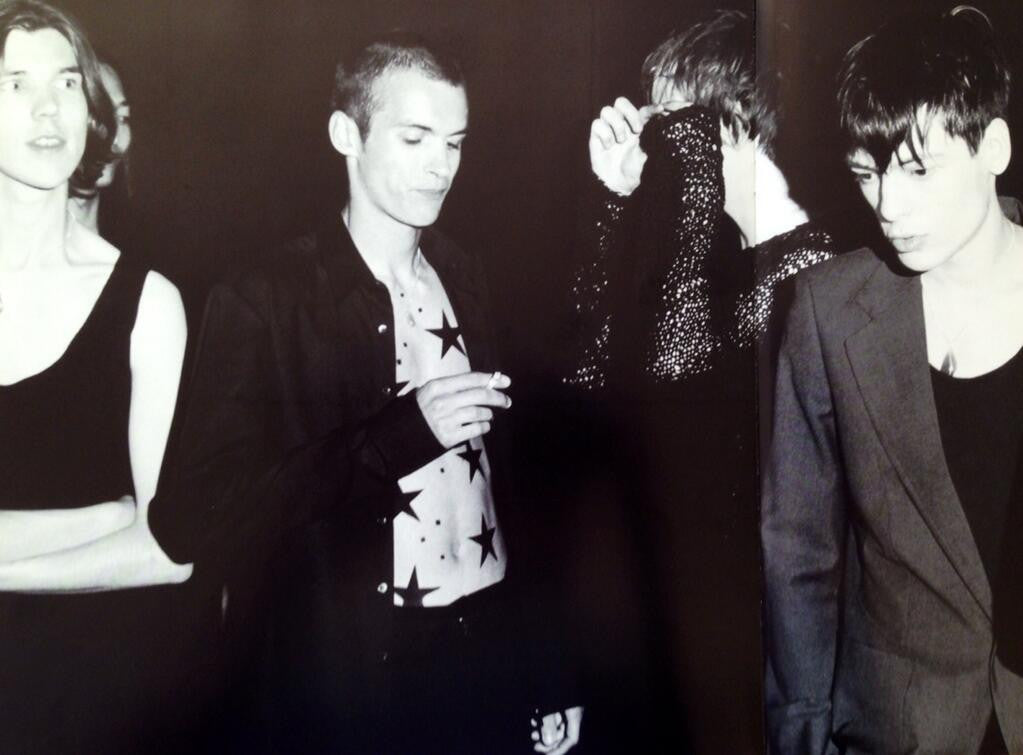Raf Simons
1997 Super 120's Wool Slim Schoolboy Blazer
1997 Super 120's Wool Slim Schoolboy Blazer
Couldn't load pickup availability
Size 46: Best for an IT 46 - 36 Chest - S or an IT 44 - 34 Chest - XS.
Raf Simons school uniform jacket from S/S 1997 '16, 17, How to Talk to Your Teen'. In excellent used condition. Made in Belgium.
S/S 1997 was Simons's second summer collection and was not presented on a runway show. Instead the collection was presented in a photographic studio in Paris, as described by Antwerp's MoMu Fashion Museum below:
'A video showing 14 teenagers who run out of school and finally come together in an imaginary U.F.O., an environment created by themselves where they can indulge their fantasies in contrast with their daily life and earthly things such as school, parents, etc. [...] The silhouette is again tight and close to the body, inspired by the Mods and the Punks in combination with schoolboys and surf boys. The materials are classical combined with vivid colours. They look old and washed off.' (our emphasis)
The collection's effortless mix of youthful printed basics and hypermodern tailoring may seem commonplace nowadays, but constituted a strong statement in itself at the time of its presentation. This classic blazer is Simons's most quintessential tailoring design, conceived during his early years and released every season until the mid-2000s. If a single garment could represent Simons's paradigm-shifting work in the 90's then this jacket would surely be it. Cathy Horyn explains:
'Simons is probably the most influential men's-wear designer of the last decade. "He did everything before anyone else, and everybody has copied him," Marie-Amelie Sauve, the stylist for Balenciaga, said. Although Simons is virtually unknown outside the small world of European men's fashion (he shows in Paris), his effect on the way young men dress cannot be overstated. Only with training, genius, intoxicating amounts of culture and possibly a discreet drug habit have a handful of designers been able to change the shape of clothes. Simons, without any of these advantages, has done it three times. The first time was in the mid-1990's, at the beginning of his career, when he came out with suits that were cut unusually small in the shoulders. [...] If Gucci's caftans and Jean Paul Gaultier's cowboy chaps didn't represent the same emotional trip to this generation, Simons's minimalist suits did. They became the dominant silhouette of the late 90's. I once asked him what made him think of that shape. As usual, he had a straightforward explanation. "It was just because we were so small," he said.' (our emphasis)
Simons's signature narrow shoulderline and razor-sharp proportions gave an unexpectedly youthful element to classic garments and, for the first time, people with slender frames could find tailoring that was designed for their profile. While Simons's much-coveted streetwear glorifies youth cultures through visuals, it could be argued that Raf Simons tailoring takes this attitude and gives it real substance though craft and sartorial know-how.
This jacket is the earliest version of Simons's iconic schoolboy blazer, a design that can also be seen in several collections that followed (pictured: A/W 1997 and S/S 1998). While maintaining the designer's signature form-fitting silhouette with structured narrow shoulders and slim sleeves, the piece is distinguished from Simons's typical blazers thanks to its curvilinear patch pockets and wide notch lapels that add a retro charm to the sharp design. It should also be noted that the lapel edges are decorated with pick-stitching done by hand, a sartorial feature that Raf rarely opted for. Likewise, the cuffs are finished with larger facing panels that allow them to be turned up without exposing the lining. The back is finished without a vent.
The piece is crafted from a substantial Super 120's virgin wool with a smooth and crisp texture. Unlike typical Super 120's fabrics which are soft and pliable, the fine virgin wool yarns have been woven into a compact structure that results in a structured material that maintains the jacket's silhouette well and does not wrinkle. The fabric has a faint striped pattern consisting of light brown and petrol blue lines on a dark brown background. The jacket's construction is executed to Simons's typical standard, with precise canvasing that gives it an effortlessly structured silhouette. The sleeves are finished with three functional buttons and the undercollar features a black felt insert. The interior is partially lined in smooth sateen and features two pockets. Finally, the neck features a grosgrain hanging tab and all buttons are crafted from genuine buffalo horn.
A beautiful and rare garment, this piece demonstrates the timeless relevance of Simons's first collections. Its sharp silhouette and clean lines look as relevant today as when it was designed twenty years ago. Strongly recommended.






